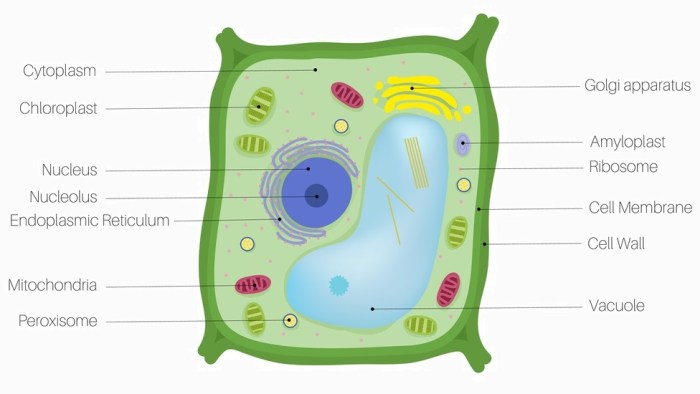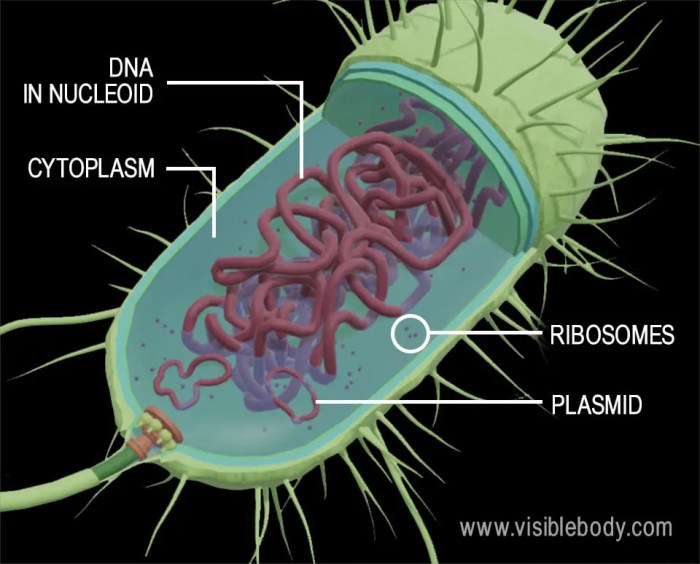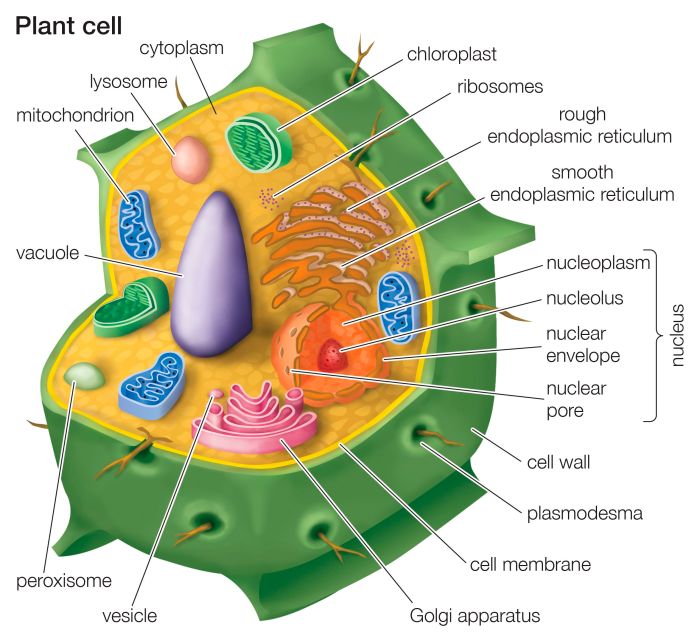Into the plant cell biobeyond – Journey into the microscopic realm of plant cells, where intricate structures and remarkable processes unfold. Dive deep into the heart of these living units, unraveling the secrets that govern their functions and adaptations.
From the sturdy cell wall to the dynamic nucleus, each component plays a vital role in the life of a plant cell. Witness the photosynthetic magic that converts sunlight into energy, and explore the intricate mechanisms that drive cell division and growth.
Cell Structure and Function

Plant cells are the basic unit of life for plants. They are responsible for all of the plant’s functions, from photosynthesis to reproduction. Plant cells have a number of unique features that distinguish them from animal cells, including a cell wall, chloroplasts, and a large central vacuole.The
cell wall is a rigid structure that surrounds the cell membrane. It provides support and protection for the cell and helps to maintain the cell’s shape. The chloroplasts are organelles that contain chlorophyll, the green pigment that absorbs sunlight during photosynthesis.
Photosynthesis is the process by which plants convert sunlight into energy. The energy is then used to produce glucose, a sugar that the plant uses for food.The large central vacuole is a fluid-filled space that occupies most of the cell’s volume.
The vacuole stores water, nutrients, and waste products. It also helps to maintain the cell’s turgor, or firmness.
Cell Membrane
The cell membrane is a thin layer of lipids that surrounds the cell. It acts as a barrier between the cell and its surroundings and controls the movement of materials into and out of the cell.
Cytoplasm
The cytoplasm is the gel-like substance that fills the cell. It contains all of the cell’s organelles and is the site of many of the cell’s activities.
Nucleus
The nucleus is the control center of the cell. It contains the cell’s DNA, which is the genetic material that determines the cell’s characteristics.
Ribosomes
Ribosomes are small organelles that are responsible for protein synthesis.
Endoplasmic Reticulum
The endoplasmic reticulum is a network of membranes that folds and transports proteins.
Golgi Apparatus
The Golgi apparatus is a stack of membranes that modifies and packages proteins.
Lysosomes
Lysosomes are small organelles that contain digestive enzymes. They break down waste products and recycle them into useful materials.
Mitochondria
Mitochondria are organelles that produce energy for the cell.
Chloroplasts
Chloroplasts are organelles that contain chlorophyll, the green pigment that absorbs sunlight during photosynthesis.
Vacuole
The vacuole is a large fluid-filled space that occupies most of the cell’s volume. It stores water, nutrients, and waste products.
Cell Wall and Membrane

The cell wall is a rigid structure that surrounds the cell membrane of plant cells. It is composed primarily of cellulose, a complex carbohydrate that provides strength and support to the cell. The cell wall also contains other components such as hemicellulose, pectin, and lignin, which contribute to its overall structure and function.The
cell wall has several important functions. It protects the cell from mechanical damage, such as crushing or tearing. It also helps to maintain the cell’s shape and prevent it from bursting when it takes up water. The cell wall also plays a role in regulating the movement of substances into and out of the cell.The
cell membrane is a thin, flexible layer that surrounds the cytoplasm of the cell. It is composed of a phospholipid bilayer, which is a double layer of phospholipids. Phospholipids are molecules that have a hydrophilic (water-loving) head and a hydrophobic (water-hating) tail.
The hydrophilic heads face outward, while the hydrophobic tails face inward.The cell membrane has several important functions. It regulates the movement of substances into and out of the cell. It also helps to maintain the cell’s electrical potential and pH.
The cell membrane also contains proteins that are involved in a variety of cellular processes, such as transport, signaling, and cell adhesion.
Cell Wall Structure
The cell wall is composed of three main layers: the primary cell wall, the secondary cell wall, and the middle lamella. The primary cell wall is the innermost layer and is composed of cellulose, hemicellulose, and pectin. The secondary cell wall is the outermost layer and is composed of cellulose and lignin.
Delving into the intricate world of plant cell biology, we uncover the fascinating processes that govern life’s foundation. Exploring the complexities of these microscopic marvels, we’re reminded of the artistic brilliance of Frida Kahlo, whose vibrant and introspective works captured the essence of human emotion.
Her captivating self-portraits, like the one depicted in Frida Kahlo by Kristy Placido , reveal the fragility and resilience of the human spirit. Returning to our microscopic journey, we marvel at the intricate dance of organelles within plant cells, echoing the vibrant colors and expressive brushstrokes that characterize Kahlo’s masterpieces.
The middle lamella is the layer that connects adjacent cell walls.
Cell Wall Function
The cell wall has several important functions, including:
- Providing support and protection for the cell
- Maintaining the cell’s shape
- Regulating the movement of substances into and out of the cell
- Protecting the cell from mechanical damage
Cell Membrane Structure
The cell membrane is a thin, flexible layer that surrounds the cytoplasm of the cell. It is composed of a phospholipid bilayer, which is a double layer of phospholipids. Phospholipids are molecules that have a hydrophilic (water-loving) head and a hydrophobic (water-hating) tail.
The hydrophilic heads face outward, while the hydrophobic tails face inward.
Cell Membrane Function, Into the plant cell biobeyond
The cell membrane has several important functions, including:
- Regulating the movement of substances into and out of the cell
- Maintaining the cell’s electrical potential and pH
- Containing proteins that are involved in a variety of cellular processes, such as transport, signaling, and cell adhesion
Cytoplasm and Cytosol
The cytoplasm is the gel-like substance that fills the cell and surrounds the nucleus. It is composed of water, salts, proteins, carbohydrates, and lipids. The cytosol is the liquid portion of the cytoplasm.
The cytoplasm is the site of many important cellular activities, including protein synthesis, cell division, and metabolism. The cytoskeleton, a network of protein filaments, helps to maintain the cell’s shape and provides support for cell movement.
Role of the Cytoskeleton
- The cytoskeleton is a network of protein filaments that helps to maintain the cell’s shape and provides support for cell movement.
- The cytoskeleton is composed of three types of filaments: microtubules, microfilaments, and intermediate filaments.
- Microtubules are the thickest of the three types of filaments and are responsible for maintaining the cell’s shape.
- Microfilaments are the thinnest of the three types of filaments and are responsible for cell movement.
- Intermediate filaments are intermediate in thickness between microtubules and microfilaments and help to provide support for the cell.
Protein Synthesis
- Protein synthesis is the process by which cells create proteins.
- Protein synthesis occurs in the cytoplasm on ribosomes.
- Ribosomes are small organelles that are composed of RNA and protein.
- During protein synthesis, ribosomes read the genetic code in mRNA and use it to assemble amino acids into proteins.
Cell Division
- Cell division is the process by which cells divide into two new cells.
- Cell division occurs in the cytoplasm and is mediated by the cytoskeleton.
- During cell division, the cytoskeleton helps to separate the chromosomes and divide the cell into two new cells.
Nucleus and Chromosomes

The nucleus is the control center of the cell, containing the cell’s genetic material. It is enclosed within a nuclear envelope, consisting of two membranes with nuclear pores that allow for the exchange of materials. Inside the nucleus, chromatin fibers are found, which are made up of DNA and proteins called histones.
Chromosomes
Chromosomes are organized structures within the nucleus that contain the cell’s genetic information. They are composed of DNA, which is coiled around histone proteins to form nucleosomes. During cell division, chromosomes become visible as distinct structures. Each species has a characteristic number of chromosomes, and humans have 46 chromosomes in each body cell.
DNA Replication and Transcription
DNA replication occurs in the nucleus before cell division, ensuring that each daughter cell receives a complete set of genetic information. During replication, the DNA double helix unwinds, and each strand serves as a template for the synthesis of a new complementary strand.
Transcription is the process by which the genetic information in DNA is used to create messenger RNA (mRNA). mRNA carries the genetic code from the nucleus to the cytoplasm, where it is translated into proteins.
Plant Cell Adaptations

Plant cells have evolved remarkable adaptations to thrive in diverse environments, from scorching deserts to frigid polar regions. These adaptations enable them to withstand various environmental stresses and optimize their function.
Plant cells possess unique structural features that contribute to their resilience. Their cell walls, composed of cellulose, provide rigidity and protection against mechanical stress. Vacuoles, large membrane-bound compartments, occupy much of the cell’s volume. They store water, ions, and other molecules, contributing to cell turgidity and providing a buffer against water loss.
Plasmodesmata, channels that traverse cell walls, facilitate communication and transport of molecules between adjacent cells, allowing for coordinated responses to environmental cues.
Response to Environmental Cues
Plant cells exhibit remarkable plasticity in responding to environmental changes. They sense and respond to light, temperature, and water availability, adjusting their physiology and metabolism accordingly. For instance, in response to low light conditions, plants increase the number of chloroplasts and chlorophyll content to enhance photosynthesis.
Conversely, under high-light conditions, they activate protective mechanisms to prevent photodamage.
Temperature fluctuations also trigger specific responses in plant cells. During cold stress, they accumulate cryoprotective proteins and alter membrane composition to maintain cellular integrity. In contrast, high temperatures induce the production of heat shock proteins, which protect cellular components from denaturation.
Water availability is crucial for plant survival. When water is scarce, plants close their stomata to reduce water loss and accumulate compatible solutes to maintain osmotic balance. Conversely, in waterlogged conditions, they activate anaerobic respiration pathways to compensate for limited oxygen availability.
FAQ Resource: Into The Plant Cell Biobeyond
What is the primary function of the cell wall in plant cells?
The cell wall provides structural support and protection, maintaining the cell’s shape and shielding it from external stresses.
How does photosynthesis occur in plant cells?
Photosynthesis harnesses light energy to convert carbon dioxide and water into glucose, releasing oxygen as a byproduct.
What is the role of the nucleus in cell division?
The nucleus houses the cell’s genetic material and orchestrates the processes of DNA replication and transcription, ensuring the accurate transmission of genetic information during cell division.